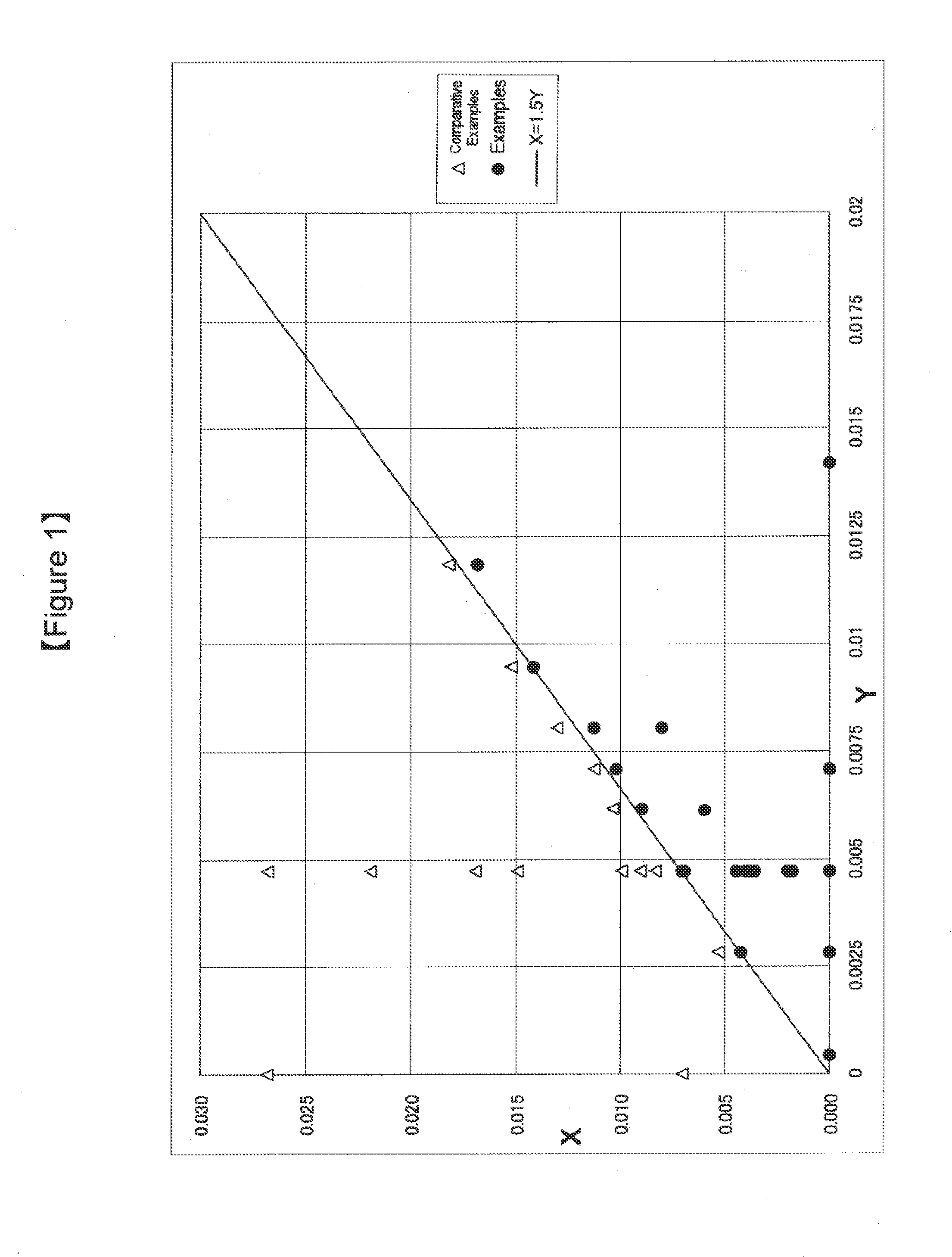Method for manufacturing rubber composition
a technology of rubber composition and rubber slurry, which is applied in the field of rubber composition production, can solve the problems of not taking into account the kneading conditions, and achieve the effects of inhibiting the reduction of increasing the activity of the coupling function thereof, and excellent low-heat-generation property
- Summary
- Abstract
- Description
- Claims
- Application Information
AI Technical Summary
Benefits of technology
Problems solved by technology
Method used
Image
Examples
production example 1
Production of Silane Coupling Agent Represented by Average Compositional Formula
[0071]
(CH3CH2O)3Si—(CH2)3—S—(CH2)6—S2.5—(CH2)6—S—(CH2)3—Si(OCH2CH3)3:
[0072]119 g (0.5 mol) of 3-mercaptopropyltriethoxysilane was put into a 2-liter separable flask equipped with a nitrogen-introducing duct, a thermometer, a Dimroth condenser and a dropping funnel, and with stirring, 151.2 g (0.45 mol) of an ethanol solution of sodium ethoxide having an effective ingredient concentration of 20% by mass was added thereto. Subsequently, this was heated up to 80° C. and stirred for 3 hours. Afterwards, this was cooled and transferred into a dropping funnel.
[0073]Next, 69.75 g (0.45 mol) of 1,6-dichlorohexane was put into a separable flask similar to the above, heated up to 80° C., and the reaction product of 3-mercaptopropyltriethoxysilane and sodium ethoxide was slowly and dropwise added thereto. After the addition, this was stirred for 5 hours at 80° C. Subsequently, this was cooled, and salt was separate...
examples 23 and 24
, and Comparative Examples 16 to 18
[0077]Next, according to the compositional formulation and the kneading method shown in Table 2, the ingredients were kneaded in a Banbury mixer in such a controlled manner that the highest temperature of the rubber composition in the first stage of kneading could be 150° C., thereby preparing 5 types of rubber compositions. In the first stage of kneading the rubber compositions of Examples 23 and 24, the rubber component (A), all the inorganic filler (B) and all the silane coupling agent (C) were kneaded, and then the vulcanization accelerator (D) of 1,3-diphenylguanidine, a type of guanidine was added thereto and further kneaded. The obtained 5 rubber compositions were evaluated in point of the low-heat-generation property (tan δ index) thereof according to the above-mentioned method. The results are shown in Table 2. For comparison, the data of Examples 1 and 6 and Comparative Example 1 are again shown therein.
TABLE 2ExampleComparative ExamplePa...
examples 27 to 47
, and Comparative Examples 20 to 32
[0079]According to the compositional formulation and the kneading method shown in Table 4, the ingredients were kneaded in a Banbury mixer in such a controlled manner that the highest temperature of the rubber composition in the first stage of kneading could be 150° C., thereby preparing 34 types of rubber compositions. In the first stage of kneading all the rubber compositions, the rubber component (A), all the inorganic filler (B) and all the silane coupling agent (C) were kneaded, and then the vulcanization accelerator of N-cyclohexyl-2-benzothiazolylsulfenamide, a type of sulfenamide was added thereto and further kneaded. The obtained 34 rubber compositions were evaluated in point of the low-heat-generation property (tan δ index) thereof according to the above-mentioned method. The results are shown in Table 4. For comparison, the data of Comparative Examples 1 and 2 are again shown therein.
TABLE 4ExampleComparative ExamplePart by mass272829303...
PUM
| Property | Measurement | Unit |
|---|---|---|
| temperature | aaaaa | aaaaa |
| mass | aaaaa | aaaaa |
| low-heat-generation property | aaaaa | aaaaa |
Abstract
Description
Claims
Application Information
 Login to View More
Login to View More - R&D
- Intellectual Property
- Life Sciences
- Materials
- Tech Scout
- Unparalleled Data Quality
- Higher Quality Content
- 60% Fewer Hallucinations
Browse by: Latest US Patents, China's latest patents, Technical Efficacy Thesaurus, Application Domain, Technology Topic, Popular Technical Reports.
© 2025 PatSnap. All rights reserved.Legal|Privacy policy|Modern Slavery Act Transparency Statement|Sitemap|About US| Contact US: help@patsnap.com

